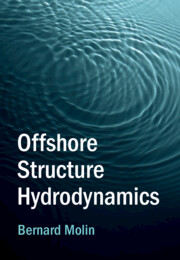Book contents
- Frontmatter
- Contents
- Preface
- Acknowledgments
- Symbols
- Abbreviations
- 1 Introduction
- 2 Environmental Conditions
- 3 Wave Theories
- 4 Wave and Current Loads on Slender Bodies
- 5 Flow-Induced Instabilities
- 6 Large Bodies: Linear Theory
- 7 Large Bodies: Second-Order Effects
- 8 Large Bodies: Other Nonlinear Effects
- 9 Model Testing
- Appendix A: Introduction to Potential Flow Theory
- Appendix B: Hydrostatics
- Appendix C: Damped Mass Spring System
- Appendix D: The Boundary Integral Equation Method
- Author Index
- Subject Index
- References
8 - Large Bodies: Other Nonlinear Effects
Published online by Cambridge University Press: 31 January 2023
- Frontmatter
- Contents
- Preface
- Acknowledgments
- Symbols
- Abbreviations
- 1 Introduction
- 2 Environmental Conditions
- 3 Wave Theories
- 4 Wave and Current Loads on Slender Bodies
- 5 Flow-Induced Instabilities
- 6 Large Bodies: Linear Theory
- 7 Large Bodies: Second-Order Effects
- 8 Large Bodies: Other Nonlinear Effects
- 9 Model Testing
- Appendix A: Introduction to Potential Flow Theory
- Appendix B: Hydrostatics
- Appendix C: Damped Mass Spring System
- Appendix D: The Boundary Integral Equation Method
- Author Index
- Subject Index
- References
Summary
This chapter tackles a few nonlinear effects that cannot be rendered by linear or second-order potential flow theory. Higher than second-order wave loads, usually denoted as ringing loads (at variance with springing which is second-order), are first considered and third-order diffraction theory is outlined and applied to a vertical cylinder. Important and ill-known phenomena that are also due to third-order nonlinearities are the wave runups often seen at sea-walls or ship hulls in beam seas. These are due to third-order interactions between the incoming waves and the radiated and diffracted waves by the structure. Example is given in the academic case of a vertical plate of finite length, where experimental results are compared with a simple parabolic model. Parametric instabilities are considered next. A long section is devoted to impact and slamming loads, where the so-called von Karman and Wagner approximations are presented along with more elaborate theoretical models. Finally the hydrodynamics of porous (or perforated) bodies is considered.
Keywords
- Type
- Chapter
- Information
- Offshore Structure Hydrodynamics , pp. 287 - 331Publisher: Cambridge University PressPrint publication year: 2023

